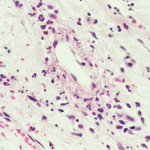The MTX regimen was not as effective in patients with extensive disease, however, and was associated with more relapses than CYC after the initial treatment period. Also, Dr. Villa-Forte noted, patients whose vasculitis involved the kidney should not be given MTX because it accumulates in patients with renal insufficiency. “I don’t think we have enough data to support that [MTX] should be started as a first-line agent” for patients with extensive disease, said Dr. Villa-Forte. Instead, practitioners “should always be thinking of a staged therapy,” she said. Her two-step approach for patients with severe disease is to first begin treatment for a short period with CYC, and then switch to a less toxic treatment like MTX for maintenance treatment. For mild to moderate disease, she advised treatment with MTX alone.
Dr. Villa-Forte has evidence for the efficacy of two-step staged approach because of her experience with 82 Wegener granulomatosis patients over 12 years, with a 4.5-year follow-up. As published in Medicine in September 2007 (86(5):269-277), patients on the staged treatment all improved. Fifty percent of patients achieved remission within six months and 72% within a year. Sustained remission was ultimately achieved in 78% of patients. However, relapse rates were high. Of the 75 patients who had any kind of remission, 45% relapsed within a year and 66% within two years. “No matter which current standard therapy we decide to use, we still have high relapse rates. We need to better understand the physiology of this disease,” she said.
Dr. Langford agreed: “In reality there’s very little data focused specifically on the issue of relapse. Ultimately, when we face how to manage, a lot comes down to what’s best for our individual patient. A lot comes down to opinion.”
Large-Vessel Vasculitides
When Dr. Bacon discussed Takayasu’s arteritis, a vasculitis disease that affects the aorta, one of the first things he stressed was that it “is not in any sense a sister disease to the small vessel vasculitides” that were discussed by Drs. Villa-Forte and Langford. “And that’s important when you try to extrapolate treatment,” he continued. “This clinical course is different and the pathology is different.”
Patients with Takayasu’s arteritis will generally complain of symptoms related to reduced blood flow in the upper neck and head, he said. Takayasu’s arteritis is sometimes referred to as “pulseless disease” because it’s difficult to take the pulse of many patients with Takayasu’s arteritis. Unlike the small-vessel vasculitides previously described, Takayasu’s arteritis has a nine-to-one ratio of females to males. It usually occurs in women under 40, and is more common among Asians.
